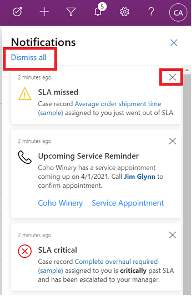
A Toast to Notifications.
The 2022 release wave documentation has been published and my original thought was to review it and write a “Top 5” list or something along those lines. However, I’m still captured by a previously (Oct 2021) announced feature that is in pre-release and should be coming.
Why am I captured? Could it be the hundreds of email notification workflows that I’ve authored over the last number of years? Yea, probably.
I cringe at email notifications for several reasons but am sympathetic to the basic reason for them being requested—that is, I want to be aware of something. At the same time, as someone who takes software adoption to heart, I know that whenever I push knowledge out of the UI I stand the chance that I also am pulling the user out of it.
Enter In-app notifications.
In-app notifications provide a “notification center” in the Dynamics 365 model-driven app that allows the system to push notifications to users within the interface.

The bell icon in the Nav bar displays a count of new notifications when the user logs into D365. When they open the notification center, this count is cleared. The user can dismiss or delete one or all the messages as they review them.

Toast notifications are also supported so users can briefly see a message if it is generated while they’re using the app.
A few key things I identified about In-app notifications that are good knowledge or points to consider as you implement them.
1. You can create notifications using the client API or the Web API. However, I’ve seen a method to create them using Flow which is exciting for us non-developers.
2. Notifications use Dataverse storage, so be very conscientious about the volume and expiration settings of your notifications.
3. There is a notification behavior setting that allows you to specify whether the notification appears for a brief duration then disappears or is only seen in the notification center.
4. Push notifications are available when you build a Power App and are not the same thing as In-app Notifications. Understand the differences between these as you consider the mobile experience.
There are a lot of customizing capabilities this feature allows, so it will be interesting to see the various implementations of the feature when it becomes generally available.
For me, the biggest promise is that the future of email notifications looks dimmer and dimmer which is the best new feature news I’ve heard in a while!
As mentioned and linked above, the 2022 release wave documentation which is over 400 pages long highlights a lot of new things happening in D365 and Power Platform generally. Almost 200 pages are focused on Sales, Marketing, and Service.
My key takeaway on the Sales features is that they generally continue to leverage more and more AI-driven functionality and a lot are specific to either Sales Enterprise or Sales Premium, so keep that in mind if you’re just launching a Dynamics 365 Sales implementation and are considering the Sales Professional license. The gap appears to be widening.
Mike Springer is a Dynamics 365 enthusiast that has been providing guidance to clients for over 15 years. As a Senior Dynamics 365 Consultant for New Dynamic, Mike is dedicated to helping companies drive revenue and reduce the cost of sales through insightful and collaborative Dynamics 365 Sales solutions.






